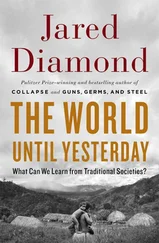Jared Diamond - Guns, Germs & Steel
Здесь есть возможность читать онлайн «Jared Diamond - Guns, Germs & Steel» весь текст электронной книги совершенно бесплатно (целиком полную версию без сокращений). В некоторых случаях можно слушать аудио, скачать через торрент в формате fb2 и присутствует краткое содержание. Жанр: 105. Описание произведения, (предисловие) а так же отзывы посетителей доступны на портале библиотеки ЛибКат.
- Название:Guns, Germs & Steel
- Автор:
- Жанр:
- Год:неизвестен
- ISBN:нет данных
- Рейтинг книги:5 / 5. Голосов: 1
-
Избранное:Добавить в избранное
- Отзывы:
-
Ваша оценка:
- 100
- 1
- 2
- 3
- 4
- 5
Guns, Germs & Steel: краткое содержание, описание и аннотация
Предлагаем к чтению аннотацию, описание, краткое содержание или предисловие (зависит от того, что написал сам автор книги «Guns, Germs & Steel»). Если вы не нашли необходимую информацию о книге — напишите в комментариях, мы постараемся отыскать её.
Guns, Germs & Steel — читать онлайн бесплатно полную книгу (весь текст) целиком
Ниже представлен текст книги, разбитый по страницам. Система сохранения места последней прочитанной страницы, позволяет с удобством читать онлайн бесплатно книгу «Guns, Germs & Steel», без необходимости каждый раз заново искать на чём Вы остановились. Поставьте закладку, и сможете в любой момент перейти на страницу, на которой закончили чтение.
Интервал:
Закладка:
[wheat, barley, rice,
hyacinth bean,
sorghum, millets]
black gram,
green gram
Ethiopia
teff, finger millet,
note 4
note 5
Eastern United States
maygrass, little
—
barley, knotweed,
goosefoot
New Guinea
sugar cane
—
Mesoamerica, India, Ethiopia, sub-Saharan Africa, and South America, supplemented in several of those areas by wool from domestic animals. Of the centers of early food production, only the eastern United States and New Guinea remained without a fiber crop.
Alongside these parallels, there were also some major differences in food production systems around the world. One is that agriculture in much of the Old World came to involve broadcast seeding and monoculture fields, and eventually plowing. That is, seeds were sown by being
HOW TO MAKEan ALMOND • I Z J
Croft Type
fiber
Roots, Tubers
Melons
flax — muskmelon
hemp — note 6
cotton (G. hirsutum), jicama squashes (C. pepo, etc.)
yucca, agave
cotton (G. barbadense) manioc, sweet squashes (C. maxima, etc.)
potato, potato,
oca
cotton G. herbaceum) African yams watermelon, bottle gourd
cotton (G. arboreum), — cucumber
flax
note 7– –
— Jerusalem artichoke squash (C. pepo)
— yams, taro —
The table gives major crops, of five crop classes, from early agricultural sites in various parts of the world. Square brackets enclose names of crops first domesticated elsewhere; names not enclosed in brackets refer to local domesticates. Omitted are crops that arrived or became important only later, such as bananas in Africa, corn and beans in the eastern United States, and sweet potato in New Guinea. Cottons are four species of the genus Gossypium, each species being native to a particular part of the world; squashes are five species of the genus Cucurbita. Note that cereals, pulses, and fiber crops launched agriculture in most areas, but that root and tuber crops and melons were of early importance in only some areas.
I Z 8 • GUNS, GERMS,and steel
thrown in handfuls, resulting in a whole field devoted to a single crop. Once cows, horses, and other large mammals were domesticated, they were hitched to plows, and fields were tilled by animal power. In the New World, however, no animal was ever domesticated that could be hitched to a plow. Instead, fields were always tilled by hand-held sticks or hoes, and seeds were planted individually by hand and not scattered as whole handfuls. Most New World fields thus came to be mixed gardens of many crops planted together, rather than monoculture.
Another major difference among agricultural systems involved the main sources of calories and carbohydrates. As we have seen, these were cereals in many areas. In other areas, though, that role of cereals was taken over or shared by roots and tubers, which were of negligible importance in the ancient Fertile Crescent and China. Manioc (alias cassava) and sweet potato became staples in tropical South America, potato and oca in the Andes, African yams in Africa, and Indo-Pacific yams and taro in Southeast Asia and New Guinea. Tree crops, notably bananas and breadfruit, also furnished carbohydrate-rich staples in Southeast Asia and New Guinea.
1 hus, by roman times, almost all of today's leading crops were being cultivated somewhere in the world. Just as we shall see for domestic animals too (Chapter 9), ancient hunter-gatherers were intimately familiar with local wild plants, and ancient farmers evidently discovered and domesticated almost all of those worth domesticating. Of course, medieval monks did begin to cultivate strawberries and raspberries, and modern plant breeders are still improving ancient crops and have added new minor crops, notably some berries (like blueberries, cranberries, and kiwifruit) and nuts (macadamias, pecans, and cashews). But these few modern additions have remained of modest importance compared with ancient staples like wheat, corn, and rice.
Still, our list of triumphs lacks many wild plants that, despite their value as food, we never succeeded in domesticating. Notable among these failures of ours are oak trees, whose acorns were a staple food of Native Americans in California and the eastern United States as well as a fallback food for European peasants in famine times of crop failure. Acorns are nutritionally valuable, being rich in starch and oil. Like many otherwise edible wild foods, most acorns do contain bitter tannins, but acorn lovers
HOW TO MAKE AN ALMOND • 129
learned to deal with tannins in the same way that they dealt with bitter chemicals in almonds and other wild plants: either by grinding and leaching the acorns to remove the tannins, or by harvesting acorns from the occasional mutant individual oak tree low in tannins.
Why have we failed to domesticate such a prized food source as acorns? Why did we take so long to domesticate strawberries and raspberries? What is it about those plants that kept their domestication beyond the reach of ancient farmers capable of mastering such difficult techniques as grafting?
It turns out that oak trees have three strikes against them. First, their slow growth would exhaust the patience of most farmers. Sown wheat yields a crop within a few months; a planted almond grows into a nut-bearing tree in three or four years; but a planted acorn may not become productive for a decade or more. Second, oak trees evolved to make nuts of a size and taste suitable for squirrels, which we've all seen burying, digging up, and eating acorns. Oaks grow from the occasional acorn that a squirrel forgets to dig up. With billions of squirrels each spreading hundreds of acorns every year to virtually any spot suitable for oak trees to grow, we humans didn't stand a chance of selecting oaks for the acorns that we wanted. Those same problems of slow growth and fast squirrels probably also explain why beech and hickory trees, heavily exploited as wild trees for their nuts by Europeans and Native Americans, respectively, were also not domesticated.
Finally, perhaps the most important difference between almonds and acorns is that bitterness is controlled by a single dominant gene in almonds but appears to be controlled by many genes in oaks. If ancient farmers planted almonds or acorns from the occasional nonbitter mutant tree, the laws of genetics dictate that half of the nuts from the resulting tree growing up would also be nonbitter in the case of almonds, but almost all would still be bitter in the case of oaks. That alone would kill the enthusiasm of any would-be acorn farmer who had defeated the squirrels and remained patient.
As for strawberries and raspberries, we had similar trouble competing with thrushes and other berry-loving birds. Yes, the Romans did tend wild strawberries in their gardens. But with billions of European thrushes defecating wild strawberry seeds in every possible place (including Roman gardens), strawberries remained the little berries that thrushes wanted, not the big berries that humans wanted. Only with the recent development of
Интервал:
Закладка:
Похожие книги на «Guns, Germs & Steel»
Представляем Вашему вниманию похожие книги на «Guns, Germs & Steel» списком для выбора. Мы отобрали схожую по названию и смыслу литературу в надежде предоставить читателям больше вариантов отыскать новые, интересные, ещё непрочитанные произведения.
Обсуждение, отзывы о книге «Guns, Germs & Steel» и просто собственные мнения читателей. Оставьте ваши комментарии, напишите, что Вы думаете о произведении, его смысле или главных героях. Укажите что конкретно понравилось, а что нет, и почему Вы так считаете.










